Enriching lives through beauty, education, and the arts.
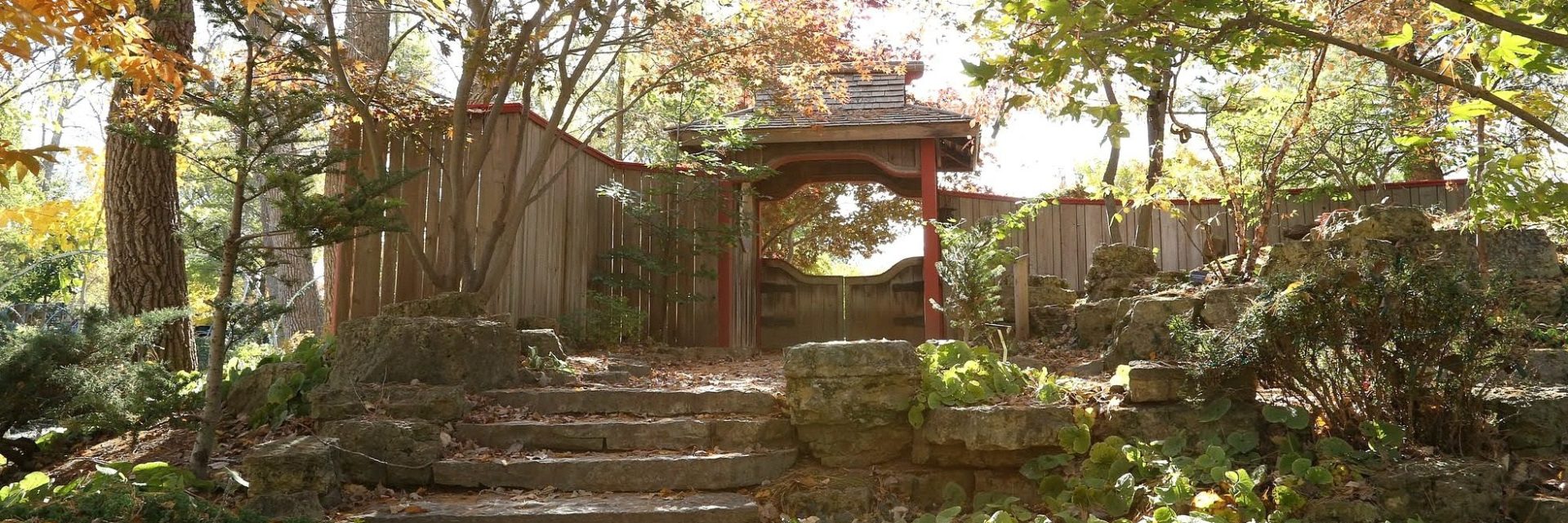
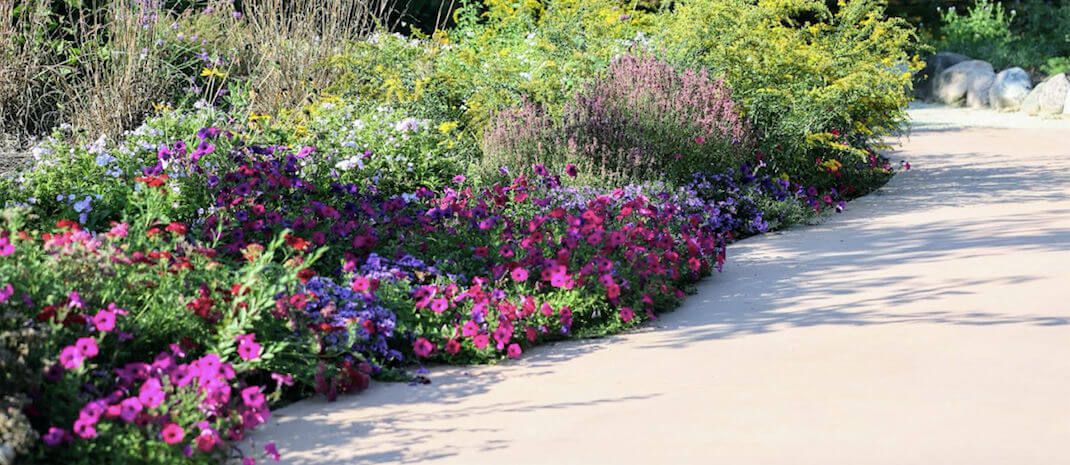
Time is taking its toll on our pathways
If you have visited the Gardens recently, it’s likely you noticed the poor condition of the Garden pathways. After 32 years of foot traffic and expected wear and tear from the elements, the paths are in dire need of our love and attention.
Many sections of the existing brick paths are uneven, cracked or broken.


Visitors of all abilities but especially those with mobility impairments, walkers, strollers, or wheelchairs, risk the chance of tripping and falling either onto the ground or into the pond. We can’t chance this happening to our loved ones any longer.
The Gardens, as a beautiful community asset, are a proven place of healing of mind, body, and soul for all ages and abilities and it’s essential to provide safe access and peace of mind for all who enter.
The proposed solution is to work with a local, small business and remove the existing path materials (prioritizing the sections that are in the worst condition and keeping the beloved memorial bricks in tact), level the ground, and install new, permeable pavers that meet ADA requirements. This will ensure that the new Garden paths are flat, level, permeable to water, and SAFE.

As a non-profit organization, the Gardens do not receive any funding from the city or state and rely solely on the generous patronage of the public to make such repairs.
This project is no small undertaking and comes with a sizeable price tag as most hardscape projects do. In total, the path removal and instillation will require ~$715,000.
Help us restore the Garden Pathways
While this figure could feel daunting, I am optimistic. We are a strong community that has proven that we come together to support what we care for.
- If you are willing to contribute to our year-end capital campaign today, we are that much closer to re-paving the Garden paths and making the Gardens accessible for everyone in our community.
- If your family felt inspired to get involved in a bigger way and leave a legacy, there are path naming right options available.
- You can make a donation of any size here
With your financial support, the Gardens will remain a safe place for natural beauty, education, and the arts.
Thank you for your consideration and for always having our back.
It takes a village but is absolutely a labor of love.
You can contact Rotary Botanical Gardens staff with questions at [email protected].

Donation helps us ditch gas-powered maintenance tools
Rotary Botanical Gardens recently received a donation that helped us reach a sustainability goal: to move away from gas powered landscape tools.
Andy and Carol Phelps answered our dreams; as true advocates for earth-friendly policies, they wanted to see that the garden’s shared passion for “going green” was attained by converting our tools to electric.

The decision-making process
Knowing this was a core investment that we would be using for many years to come, we had a lot of homework to do to decide which products to put our money towards. We did the research on what tools were available, considering power, cost, and battery compatibility.
Ultimately, we decided on EGO tools. The fact that EGO had the fastest charge times (the chargers come with small fans that pulls away heat from the batteries), a riding mower in its fleet, and that all its 56V batteries work on all of its tools made it a no brainer to go with EGO.
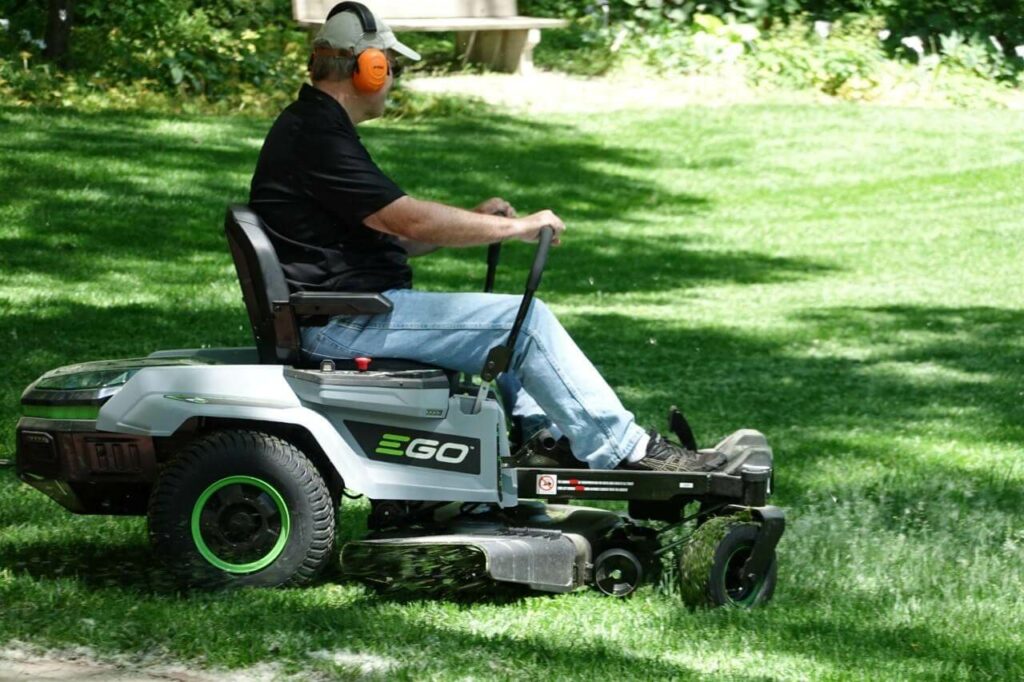
Battery power has great benefits
The benefits of shifting to battery powered have been numerous and the new tools have quickly become staff favorites.
The most obvious advantage is that compared to gas, they are a better choice for the planet. The Environmental Protection Agency (EPA) has estimated that running a lawn mower for an hour generates emissions closer to 350 miles of car travel, about the distance from Janesville to St. Louis.
As someone who has used gas powered tools for many years, I can tell you from firsthand experience that it isn’t a great sensation to run a backpack blower or snow blower for an hour or two and smell like fumes, not to mention breathing in the engine exhaust.
It is common for Garden staff to experience frustration in getting gas powered tools to start. Mixing fuel represents an environmental issue in itself as run off from mixing with oil or filling a gas tank ends up on the ground and eventually into our soil and water. California has already banned the sale of gas mowers and blowers, while Illinois and New York are considering similar action.
Electric tools mean no fuel mixing, pulling a cord, wondering if you have a bad spark plug, clogged carburetor, dirty air filter, or diagnosing something else. The reliability of putting a fresh battery in and going to work is refreshing.
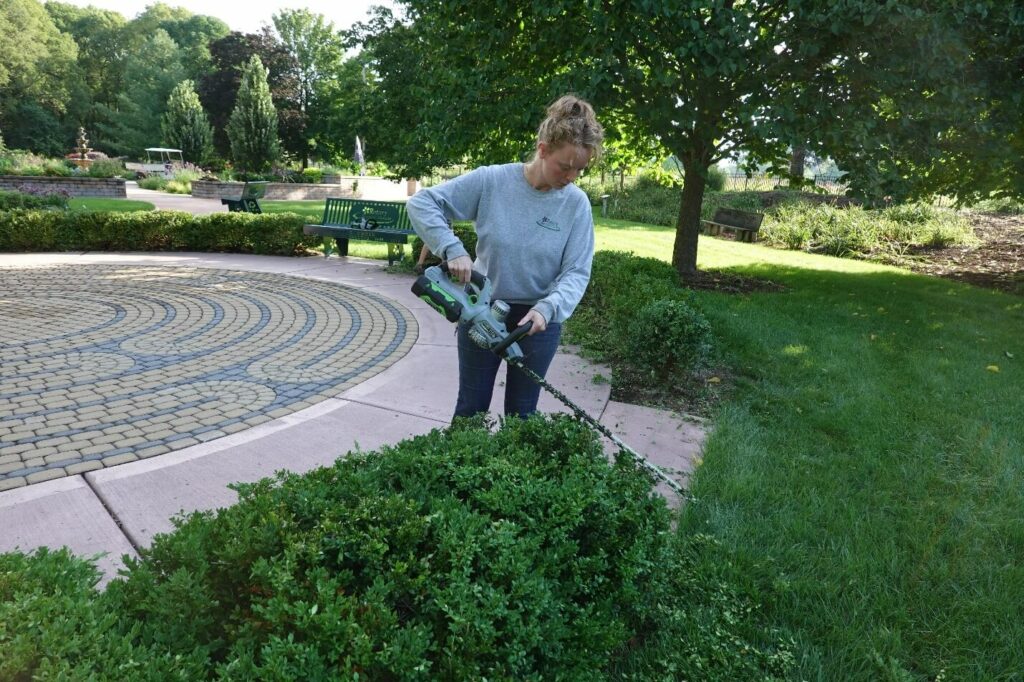
But do they work as well as gas power?
A common question is, ‘Are the tools powerful enough?’ After using them for a few months, the resounding answer is YES!
All the tools are at least as powerful as their gas counterparts; the handheld blower and hedge trimmer are distinctly stronger. The tools run much quieter than typical gas, although hearing protection is still required for the operator, and are made more efficient in part because of their brushless motors.
We also love the innovation that EGO brings to make tools better. One of these features includes string trimmers that are automatically wound and require no bumping. The hedge trimmer has a blade that cuts on both sides and a feature that turns your grip, to avoid being in a painful position.
The chainsaws have an easy chain tension feature, and the blower pushes out air at over 200 mph. We can’t wait to test out the two-stroke snow blower this winter.
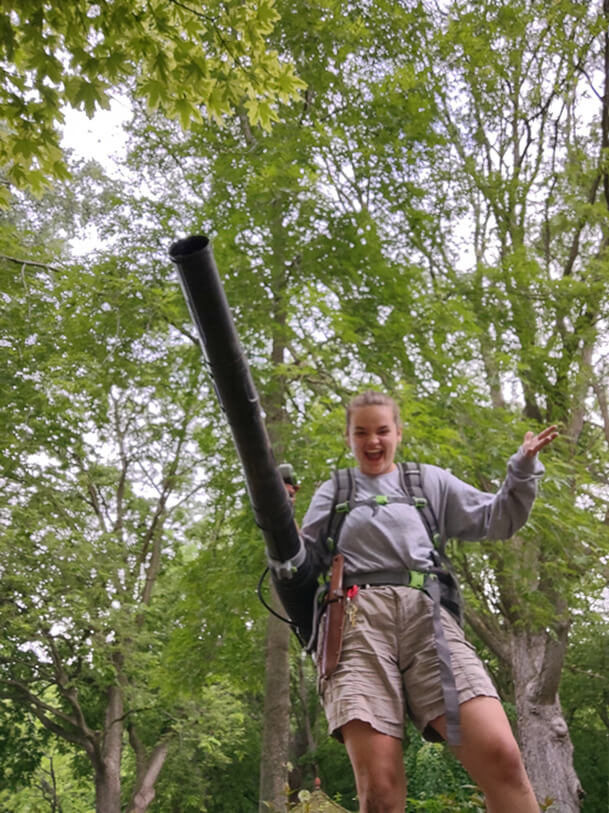
Saving the planet and dollars
Furthermore, the timing of the transition could not have been better. With gas prices nearly doubling from what they were last year and at times nearing $5 a gallon, the cost to keep our old gas-powered tools running would have been exorbitant.
The initial sticker price of electric powered tools is higher than gas, but the cost savings is realized quickly when you factor in fuel and maintenance costs.
We aren’t the only ones who are switching over to electric power tools. Several other public gardens are doing the same, as well as the general public, as market research via the Freedonia Group expects sales of electric powered landscape tools to reach $14.1 billion by 2024.
Going green is a hill we’re proud to stand on; We hope that others will consider our experiences with battery powered tools when it comes to purchasing their next landscape tools.
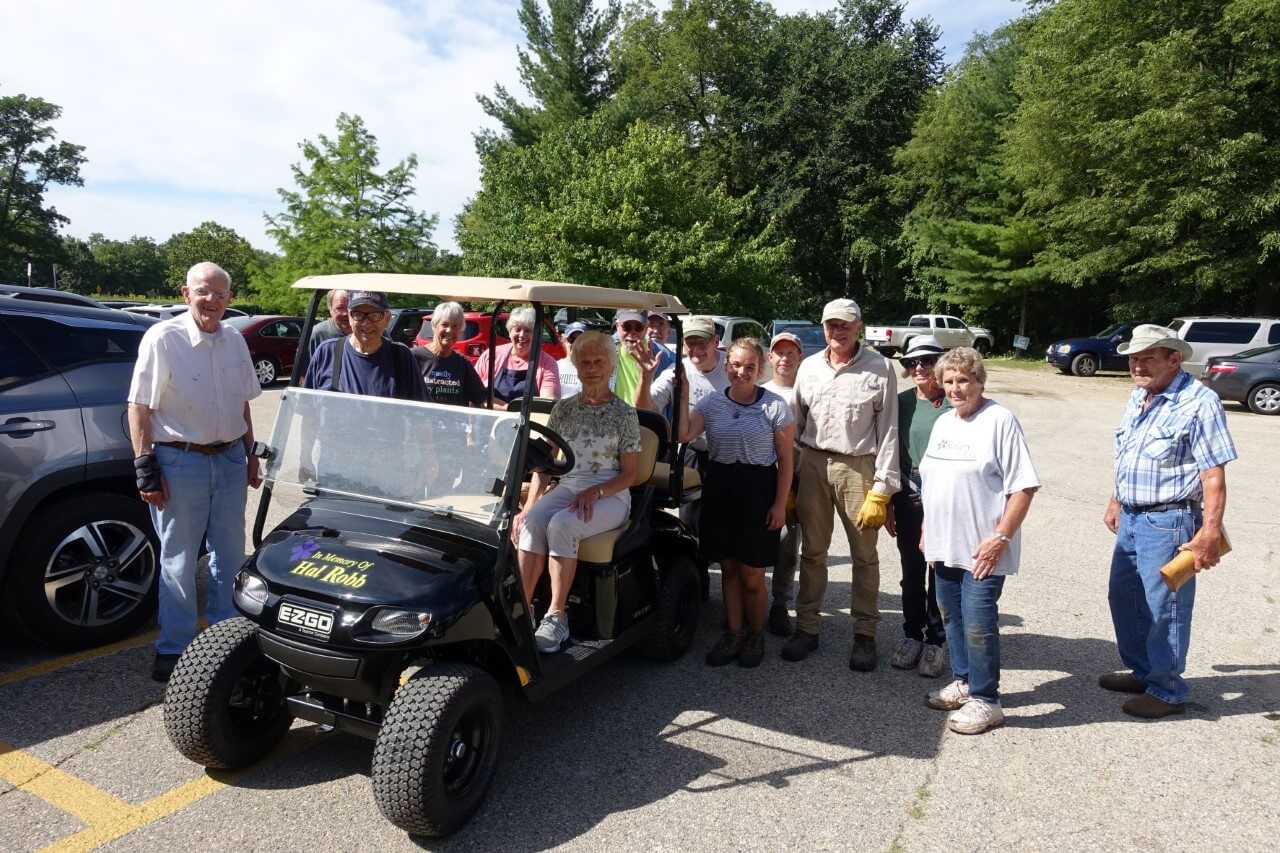



This post was written by Emma Wallace, RBG Horticultural Intern
What a great experience
As my internship at Rotary Botanical Gardens comes to a close, I am beginning to reflect on my time here. I have learned lots about plants, but what I’ve learned about people and mindsets, I will carry with me the rest of my life.



Finding my place at RBG
First, I’ll let you in on what I’ve been working on this summer. I have done lots of planting and weeding, in addition to plant identification, building planters, coming up with inspiration, leading volunteer groups, guiding tours, and any other odd jobs Michael decides to find for me to do.
I spent lots of my time planting and weeding the Reception Garden, as well as the Sunken Garden. I attempted to make floating Iris boxes (and failed), but it was the effort that counted, right?
It’s amazing to think that trees I have planted this summer will be enjoyed by thousands of people over the years, and that I will get to watch the gardens I helped with mature into established beds. This garden has become my own garden in a way I wasn’t expecting it to be at the beginning of the summer.
Lots of jobs feel like a separate place from home that you commute to, but the Rotary Gardens has really become Mine. Obviously, it’s not, but the pride I feel and the community we have here makes it feel like home. I will always look fondly on my time here for that reason.
A summer made better by a community
One of the main reasons for my joy here is the community of volunteers and workers here. As many of the volunteers are older, I feel like I have adopted 20 new grandparents that I adore and that love me just as much as I love them. They have all been my teachers in many ways, especially the ones I got to work with one on one.
I wish I could have gotten to work more with everyone here, but here’s some of what I learned from the volunteers I got to work regularly with.
Del
Del is a blast to work with, super upbeat and cheery. She has many great ideas about the gardens, and I love brainstorming with her. She does amazing work for the education and horticulture department, always pushing forward and creating new programs and ideas. She is an absolute joy to work with, and I will miss her a lot.
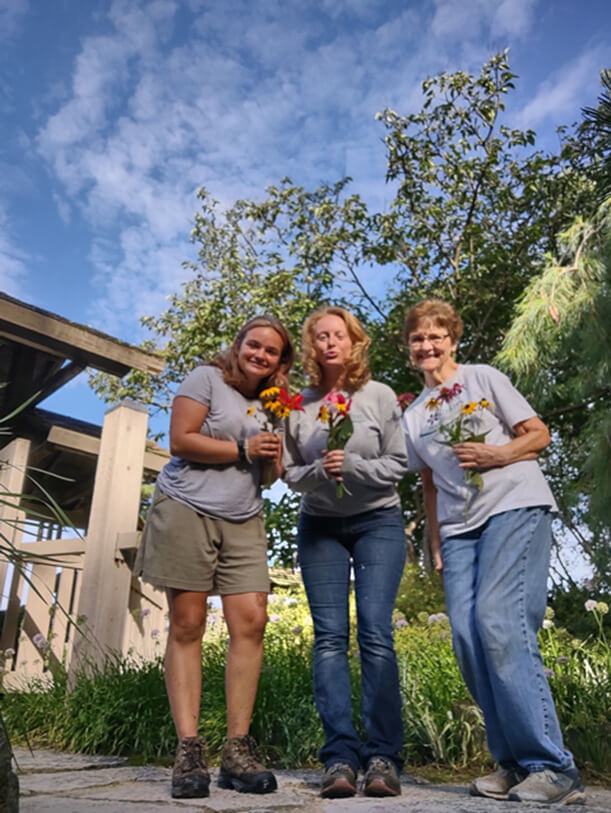

Doris
Doris is one of the hardest workers I know. She is also a great leader and is always motivating her peers to accomplish more. She donates not only time to this garden, but a deep love and care for the gardens that spreads to everyone working with her. She is extremely sweet and kind as well. I just adore Doris, and she is such a role model.
Janet
Janet taught me the place that precision has in gardening. She is the most meticulous person I have ever met. No detail is left unnoticed by her, and it shows in her work. She is often in the Moss Garden with tweezers, getting the tiny weeds I couldn’t even notice. She is always happy to be here, and it is contagious. I am a better gardener from knowing Janet.


Cookie Cathy
I worked with Cathy a lot this summer, and I am blessed to have gotten to. Cathy is the type of person to give you the shirt off her back if you needed it. She brings in cookies every Monday for us, and everyone gets excited when they enter the break room because they know they will get to enjoy her delicious treats.
Barb
Barb is the unofficial ringleader of the volunteers; she gets so much done that it is unbelievable. The way she organizes the story walk every year and how it turns out is genuinely impressive to me. The other volunteers call her the ultimate grandma, always taking care of everyone and making sure everyone has everything they need.
Cathy M
Cathy is another incredible worker here, who always comes in with a smile. She always checks in on me and makes sure I am taking care of myself in the heat, as well as that I am in good spirits. She helped me on a day I was sick, and it meant a lot to me to have her support.
Ava
I haven’t talked much to Ava, but she is probably the hardest worker I know. She gets down to business. She is also extremely meticulous and precise, but she somehow still works extremely fast and effective. She is the gold standard of a worker.
Richard
If Richard came into work, it was a guaranteed good day, and he regularly made my day when he surprised us with his presence. He is hilarious, meticulous, passionate, and caring. He always tells me stories about his family, and it is so clear how much he loves and cares about them.
He taught me a lesson that I needed to learn not just for work, but for my life, which is to slow down and enjoy the process of doing things. He’d regularly tell me to slow down while I work, not to an unproductive level, but enough to not be flying by the seat of my pants so that I could enjoy my work and efforts.
His pride in his work is contagious, in addition to his compassion for others. He wears the Grumpy hat, but he is the farthest person from Grumpy that I have ever met.
Casey
Casey and I got to work on many projects together. He was shy at first, but I soon realized he is always thinking something witty and hilarious. He is extremely hard working and is always covered in mud to the point it is comical. Casey is a great listener and greater friend, and I am very glad to have met him this summer.


Brian and Larry
I didn’t get to work much one on one with either, but they are both hard working staples to Rotary gardens. Without them, the gardens would simply not function. Brian is very diligent and kind, and Larry is always off doing some crazy job. Both of them are the foundation of this place, and they do fantastic work.
Michael
Obviously as my boss, I’ve probably learned the most botanical things from Michael. He’s taught me identification and all about plant care in multiple facets. He’s taught me to pay attention to the details, the importance of sustainability, and how to achieve it on a bigger scale.
He’s a great boss, always open to suggestions, compassionate but direct, efficient but not at the loss of fun or community, and always understanding. He also knows just about every plant in the gardens, including the scientific name, and that has lit a fire under me to retain more names. I am beyond grateful for the opportunity to work here and learn from him.
Thanks for a great internship experience!
Overall, I am eternally grateful for my time here. It has been foundational for my education. I am excited to take what I have learned with me back to school this fall.
Thank you to all the volunteers and workers who made this job so special. Thank you to all the donors who made my job possible as well. Lastly, thank you Michael for the opportunity!
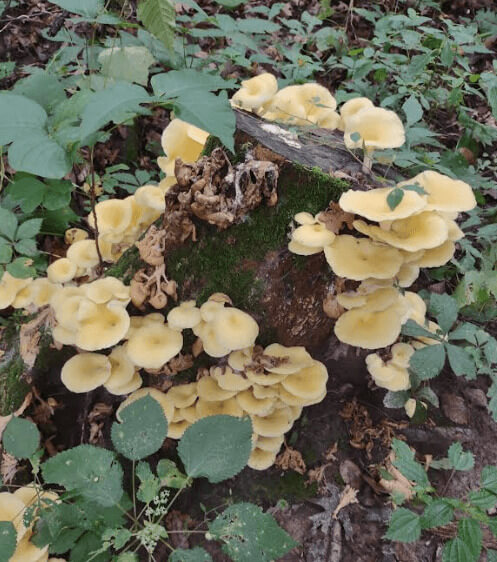

Mushrooms and fungi play important roles in the ecosystem
This post was written by Emma Wallace, RBG Horticultural Intern



I think most of us grow up thinking of mushrooms as this unknown, scary, forbidden entity that should not be touched or they will harm you in some way. However, this could not be farther from the truth.
Mushrooms and fungi actually are responsible for keeping our ecosystem running; they decompose waste, create symbiotic relationships that create nutrient pathways for trees, provide food for many creatures, and are all around fascinating creatures. They seem to run in the background, performing tasks we don’t even realize that hold up our planet.
Today I am going to attempt to scratch the surface of this world, starting with some friends you probably have growing in your yard. Some of them are great for soil, some are edible, and some are the ones your mom warned you about.
Please do not eat them, including the edible ones, unless you are experienced! This is merely just to introduce you to a world you may not know much about. All of these have been found at the gardens, so they can be a new thing to look for on your next visit!
Lets dive in!
Wood mushroom (Agaricus silvaticus)
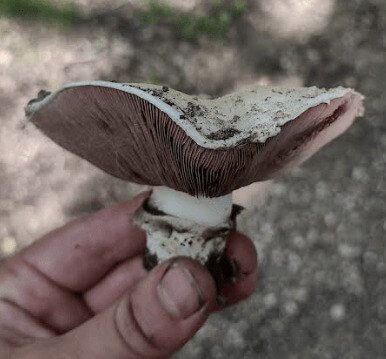

I have found tons of these cute white mushrooms around the gardens in the mulch and around trees. It is fairly easy to identify: it has brown gills with brown spores, a white cap and stem, and typically has a ring from the membrane from which it emerges.
It is not edible in most field guides, but does make sweet fairy rings. This is such a lovely mushroom, and it always makes my day to find it because of how cute it is.
Oyster mushroom (Pleurotus ostreatus)


These are the classic edible mushroom, and they have even made their way into nearly every grocery store. They are extremely delicious and taste kind of like fish. They are also super easy to identify!
They have decurrent gills that tunnel all the way down the stem. They are also typically yellow, but also can be white or brown. They are found on dead or dying hardwood trees.
Pheasant backs (Polyporus squamosus)
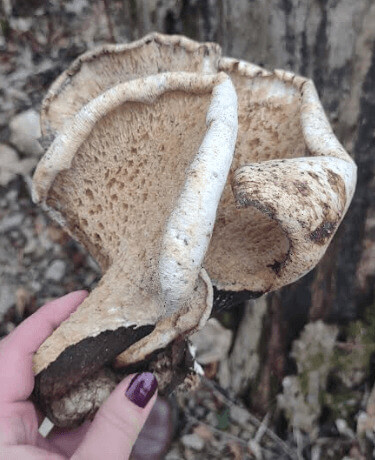

Another edible friend! Pheasant back mushrooms are also saprotrophic like oyster, meaning they grow on dying trees. These fellas smell like watermelon and have a pheasant back pattern on their caps, hence the name.
They have black stems, and very large pores. Only the small ones are edible, as the big ones get very woody.
Turkey tails (Trametes versicolor)
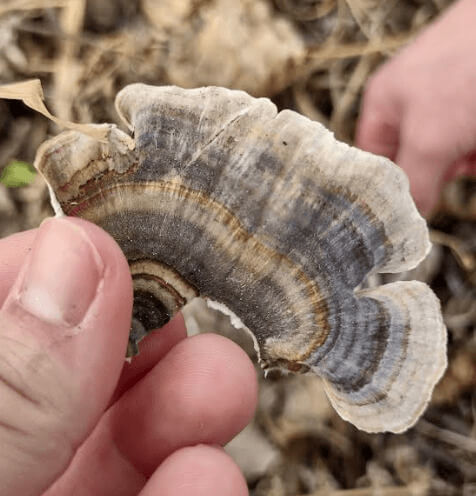

A mushroom that prevents cancer? Turkey tails are currently being studied for their crazy medicinal properties.
This mushroom also grows on dying trees. Here’s some identification features: rings of multiple, contrasting colors of grey and brown, fuzzy grey hairs, tiny white pores, and extreme flexibility. There are many look-alikes, but none of them are poisonous.
I have seen them completely cover logs, which makes for a beautiful sight.
Puff balls (Lycoperdon perlatum)
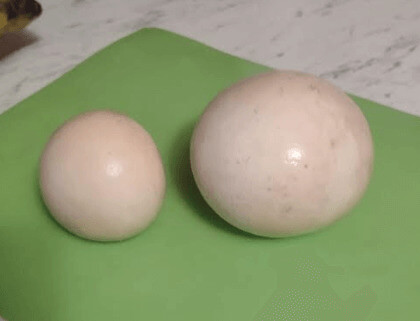

You’ve probably played with puffball mushrooms as a kid, likely kicking them and watching them explode. They are the easiest edible mushroom to identify because of their very large, white, spherical shape. The edible ones are solid white throughout the mushroom, not black or yellow like the non-edible ones.
They are fantastic in soups or as a keto pizza crust! When dried, they earn their namesake, as if you touch them, a spray of spores will fill the air like a dust. These are very entertaining, especially to kick and explode.
This is only the tip of the iceberg
Like I said, this is merely an introduction to mushrooms so that you may begin to enjoy them in addition to the plants at the gardens. If you are interested in learning more, I highly recommend picking up a field guide, as they are extensive and very interesting.
If you have any questions, feel free to email me at [email protected]! I would love to chat with you, as this is one of my passions.
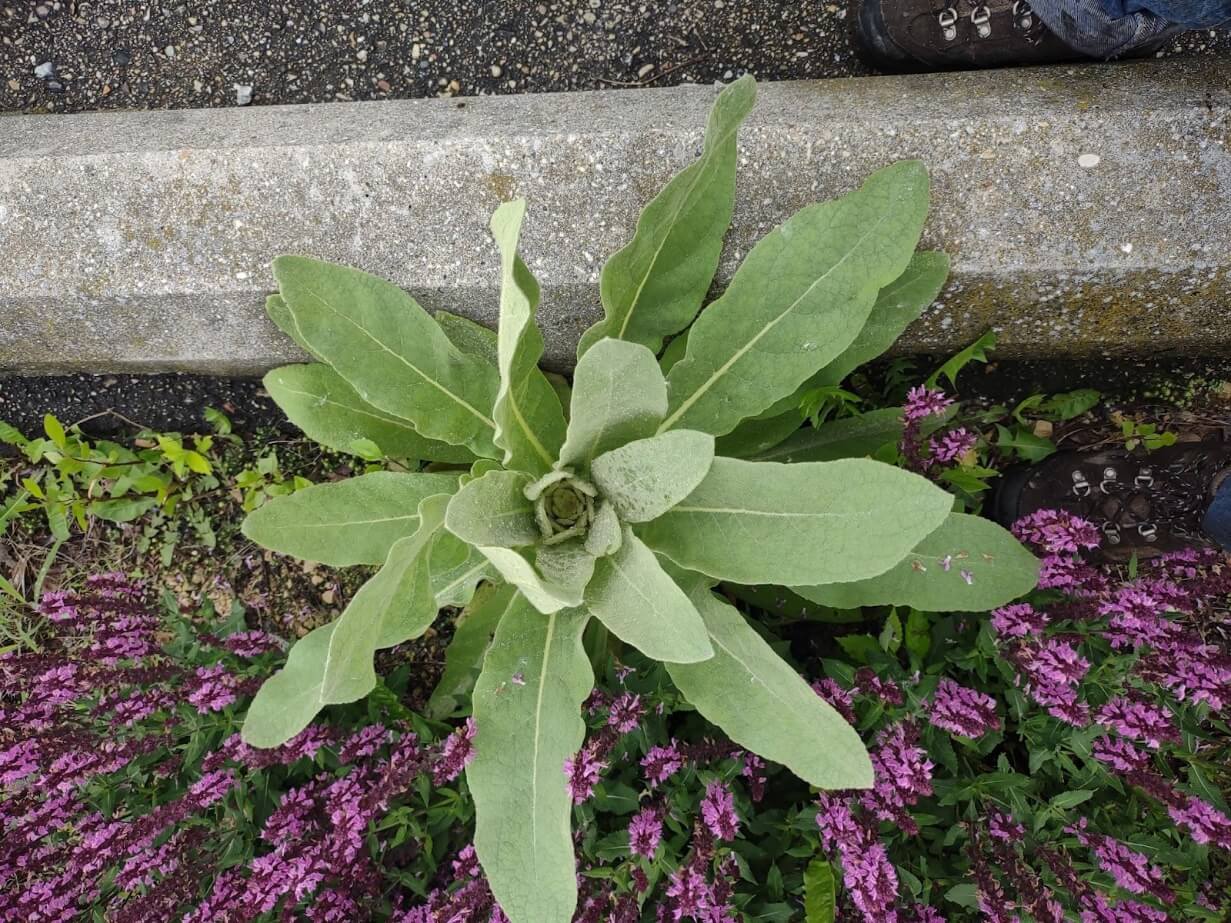

Weeds are more than just ‘pests’
This post was written by Emma Wallace, RBG Horticultural Intern



In the past, Indigenous peoples of North America made use of the same plants that we pull out of our gardens and mindlessly toss aside as ‘weeds.’ We all dread pulling these pests, but if we change our perspective, they can be an additional source of food and medicine from our gardens.
My name is Emma Wallace, and I am the summer 2022 horticultural intern at the Rotary Botanical gardens. I am a senior Horticulture student at the University of Wisconsin Platteville, and some of my passions are sustainability and permaculture in modern gardening.
Something I have become increasingly excited about is foraging. Many of the amazing plants I find on forays are extremely easy to identify and collect, and many can be found in your vegetable garden as ‘weeds.’
So, what even is a weed? A weed is any plant that is unwanted in a specific area or creates an issue for cultivated plants. The emphasis I am going to focus on is the unwanted part.
Now I’m not saying you need to love chickweed or thistles, but it is important to realize that all plants have different functions than just simply being a chore to pull. Today we will be looking at ways you can use ‘weeds’ in different ways than you may have previously considered, specifically in the kitchen.
Mullein (Verbascum thapsus)
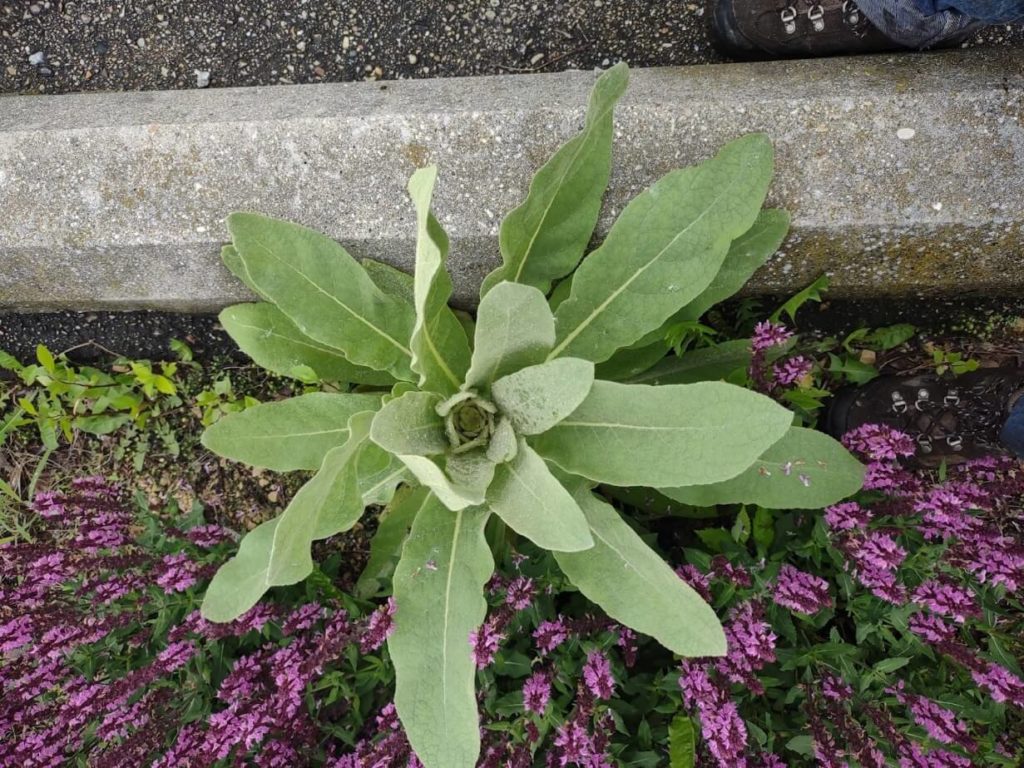

First up is Mullein, Verbascum thapsus. You may have seen this fuzzy friend before and tossed it without knowing that this plant is better than any cold medicine on the market.
Mullein has long been used by indigenous peoples in the Americas, as well as the Romans and the Zuni people, for a whole list of uses. My personal favorite use of mullein is as a cough medicine. It has long been used to treat asthma, pneumonia, as well as the common cold, to ease coughing and lung ailments.
In addition, Western colonizers used to stuff their shoes with mullein to keep warm in the freezing winters, and the Zuni peoples used to as skin salve.
Harvesting Mullein is simple. First off, you must find it. It loves open, disturbed areas and is quite easy to spot, as it gets very wide and very tall.
You will notice a rosette shaped plant with fuzzy, silver leaves arranged radially from the center of the plant. Once you have properly identified the plant, remove a few leaves from the top of the plant, as the bottom ones are older and less nutritious.
After you harvest it, you have a few options. The Native Americans generally used to smoke it in order to get the medicine into the lungs directly, however I do not recommend this method unless you already are a smoker of some nature, as it may irritate your lungs if you are not used to inhaling smoke.
The most popular modern method of consuming is by adding it to tea. To enjoy, simply add dried or fresh leaves to near boiling water, as well as any other tea you might enjoy.
Dandelions (Taraxcum officinale)
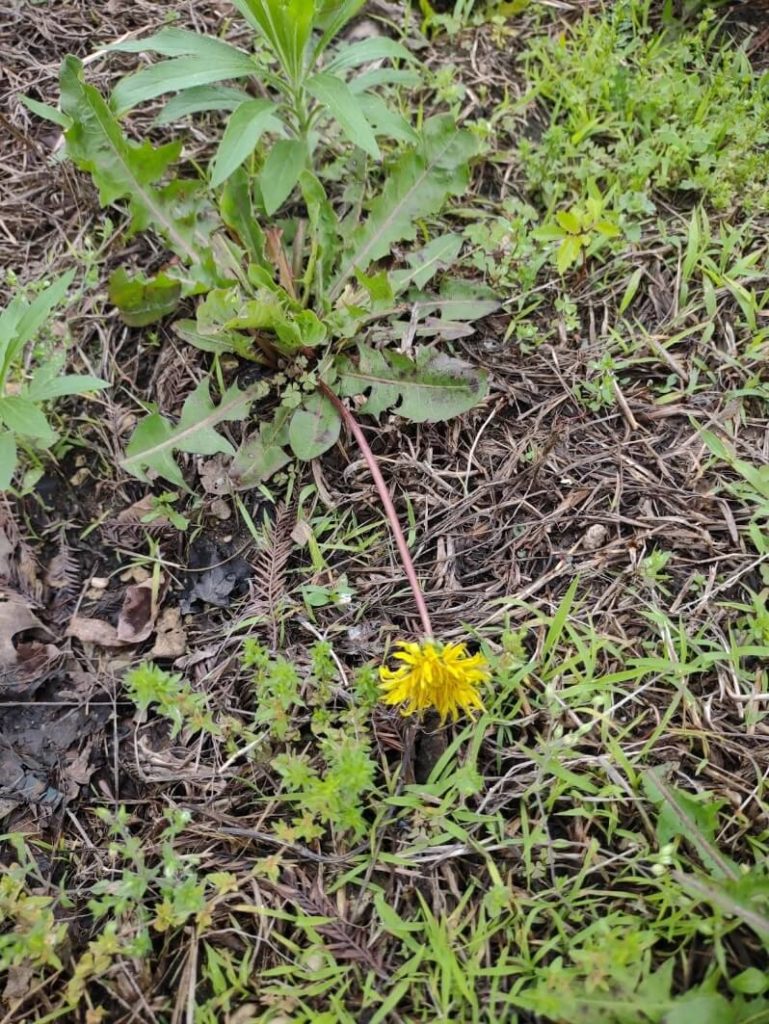

This next one, I don’t even need to list identification features; you already know it. One of the most hated weeds, dandelions, Taraxcum officinale, are a nutritional and medicinal powerhouse.
Everything but the stem can be used in very interesting ways. The roots can be roasted and ground into a coffee replacement, the leaves can be used as a bitter green, and the flowers can be made into an insurmountable number of things such as tea, salve, deep fried fritters, and so on.
Personally, I like to let this weed grow freely in my garden as an addition to my staple tea garden plants. Dandelions are extremely good for you. They are high in carotenoids, vitamin K, vitamin A, B12, and honestly an entire laundry list of others.
I think they are also one of the tastiest and most versatile weeds you can find growing in your garden. Dandelion wine, anyone?
White clover (Trifolium repens)
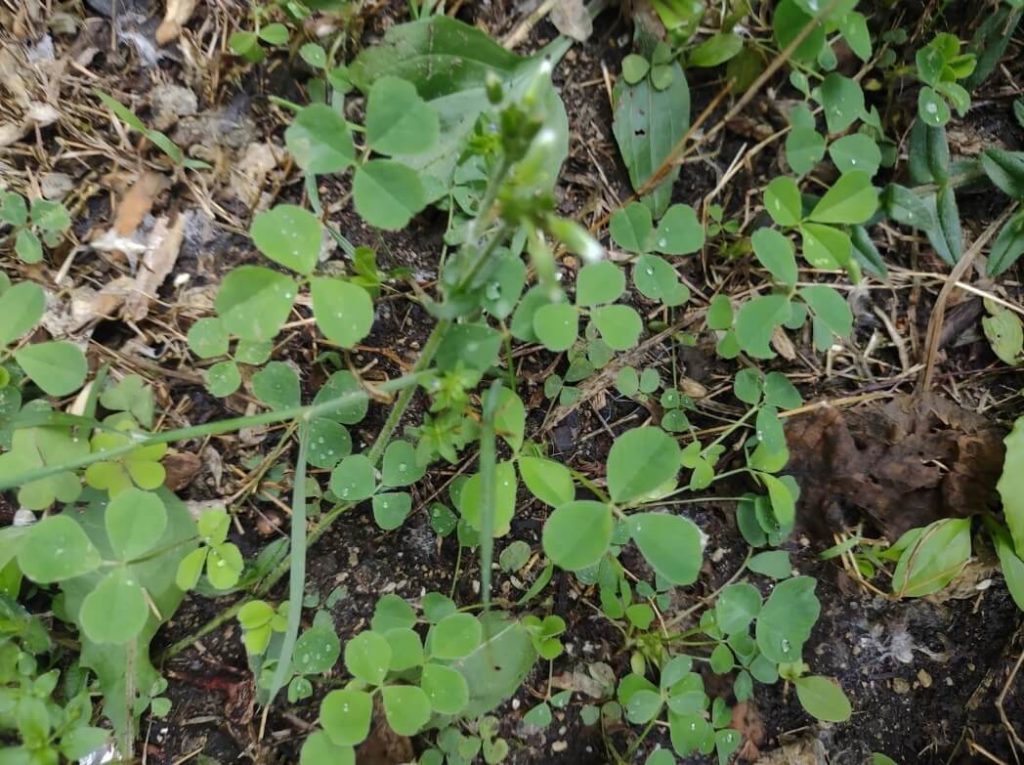

This plant has another flower you can easily recognize, white clover Trifolium repens. Easily distinguishable by its famous tri-palmately compound, shamrock leaves and shaggy white flower, white clovers are another fantastic edible that I can guarantee you are already pulling out of your garden
The leaves are said to taste like vanilla, and many make jams and sweets from the cute flowers. A similar situation applies to its cousin, the Red Clover, which has a similar leaf shape with an additional silver V marking, and it has larger pink flowers that have the same shape as the white clovers.
Broadleaf Plantains (Plantago major)
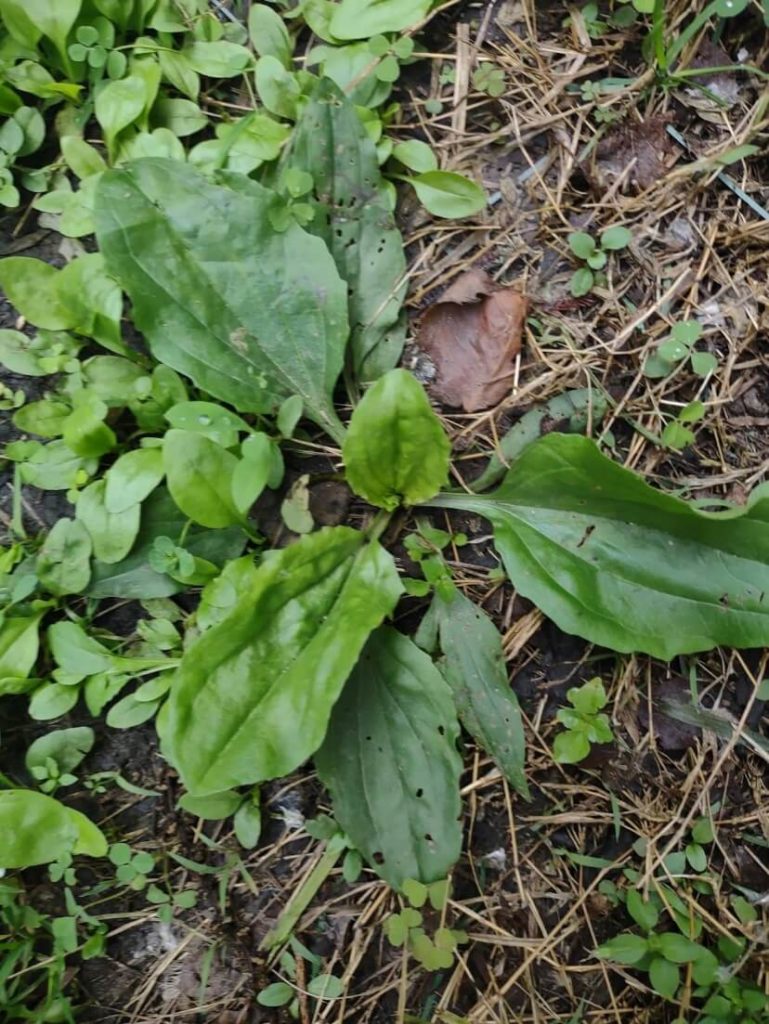

Next, we have Broadleaf Plantains, Plantago major. No, not the banana kind, but the kind you see in the cracks of your sidewalk that no matter how much you pull them they manage to find their way back.
Think of plantains as free spinach. It’s abundant, and tastes like nothing, perfect for throwing into soups or salads as a great source of vitamins A, C, K, and iron.
Plantains have circular leaves with palmate veination. They stay about the size of your hand and send up a tall stem with a whitish, cone shaped flower. They can be used any way spinach or kale is used and can also be infused into a salve to soothe skin irritations.
Burdock (Articum spp.)
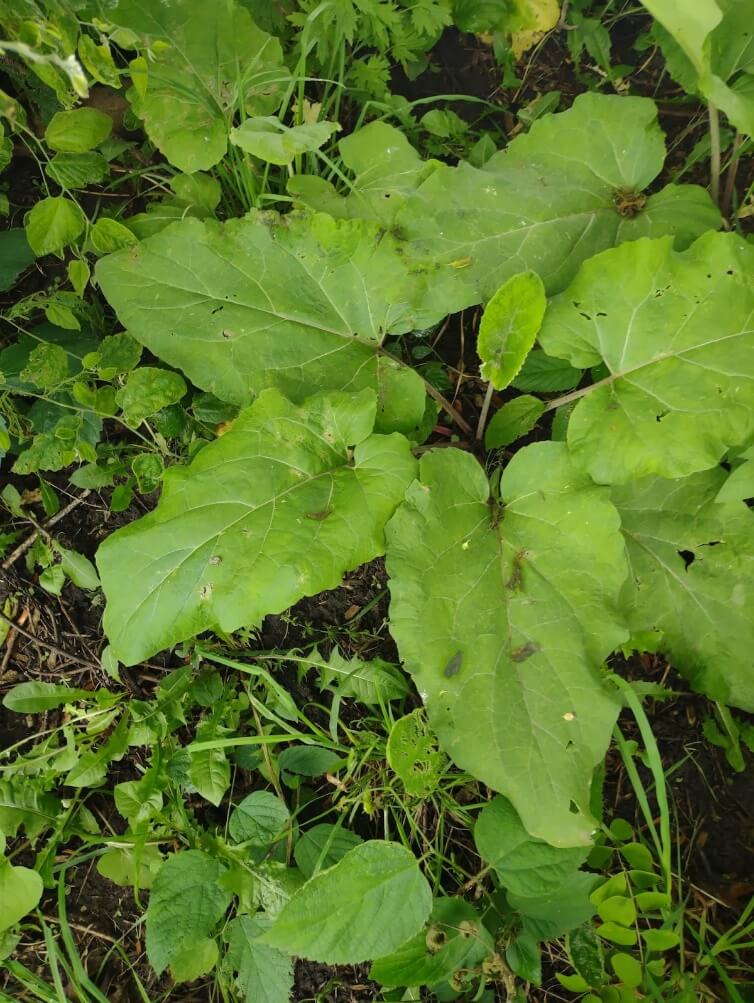

This next plant is another one you are very familiar with, but probably couldn’t identify the plant if you saw it without its hallmark: the burrs. Burdock, Articum spp., is the plant responsible for the Velcro-like burrs you find all over yourself after a hike or day in the garden that seemingly come out of nowhere.
This plant is extremely easy to identify when the seed pod burrs are on it, but also when it does not. People may think this plant is some form of wild Rhubarb because of its thick, U-shaped stems and lanceolate leaves.
The roots, leaves, and petioles are all edible, the most consumed being the roots, especially in Asia, where it is a staple food. The roots are used much like carrots or other root vegetables to create a unique flavor.
Garlic Mustard (Alliaria petiolata)
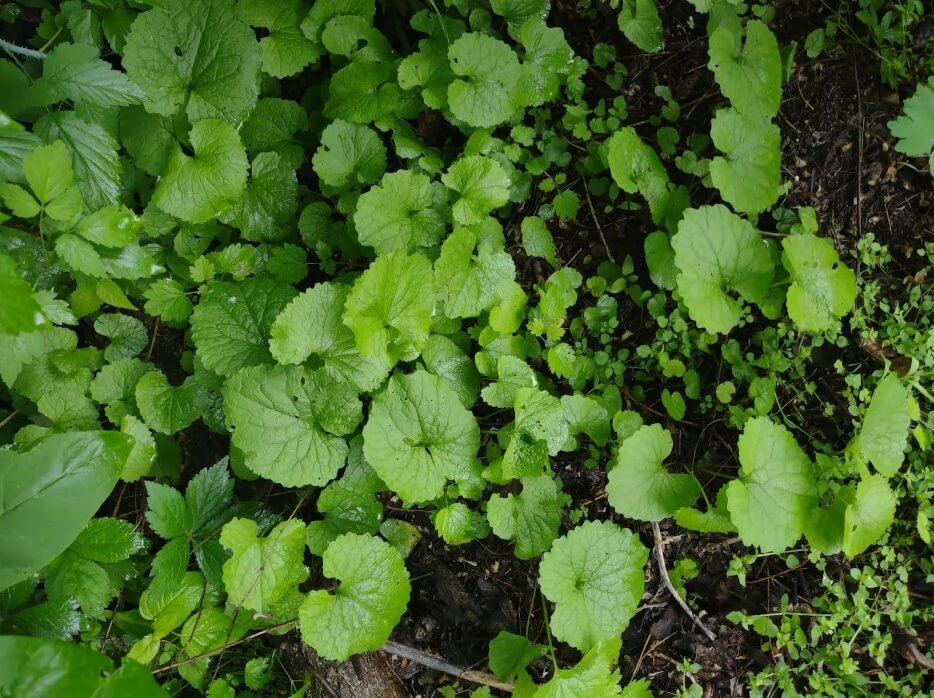

Lastly, it would be wrong of me to not include Garlic Mustard, Alliaria petiolata. This plant is highly invasive in our area, so if you find this plant in your garden, or even on a hike, make sure to remove the entire plant thoroughly.
Garlic mustard is very easy to identify; it has ruffled, wavy leaf margins with a lily pad shape. It also, unsurprisingly, smells very strongly of garlic. I have made a pesto from this garden terror, and it tastes a lot like horseradish. It’s a very good plant to use as an herb in your kitchen!
A short disclaimer: Please be responsible when consuming foraged goods, even from your backyard. Only eat plants you can positively identify for certain, and never eat plants that have been sprayed with pesticide.
I really enjoyed sharing this topic with you, and I hope you learned something new. If you want to learn more, there are plenty of amazing foraging books on the market, as well as fantastic online resources.
